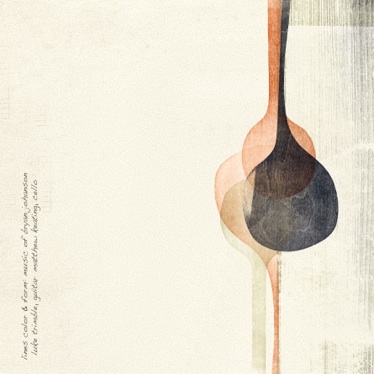THIS DEBUT recording by guitarist Luke Trimble and cellist Matthew Keating, features works by the American classical guitarist and composer Bryan Johanson.
The guitar and cello together present an intriguing set of challenges and possibilities. The guitar is plucked. The fundamental sound of each note is followed by immediate decay. In contrast, the cello is bowed. It is much louder and swells with sustain. And while the cello has been in favor for nearly 300 years, the modern guitar is still emergeing as a concert instrument. As a result, there is very little music available for the two instruments.
Bryan Johanson’s unique mixture of capricious eclecticism brings the guitar and cello together not as distant relatives, but as a matched pair. It is with great care and familiarity of the guitar’s timbres and techniques, and the cello’s rich palette of color and nuance, that Johanson enables in this unusual duo a most unique and remarkable voice.
This recording is a small sample of an invaluable collection of music that Bryan Johanson has composed for guitar and cello. While this project hopes to expand the guitar’s repertoire and to make the classical guitar attractive to a wider audience, it is above all and most genuinely inspired by the pure joy that comes from playing this remarkable music.
Spring, Op. 1, written in 1977 for guitar alone, is Bryan Johanson’s first completed work. It offers an extraordinary look at a young composer, and a peerless impression of youth and vigor. Rigorous counterpoint, pithy harmonies, and lyric melody elicit a striking musical voice that is both emergent and sublime.
Domenico Scarlatti (1685-1757) was an Italian composer who spent much of his life in the service of Portuguese and Spanish royal families. His fame rests almost exclusively on music for solo keyboard and is best known for the roughly 555 keyboard sonatas composed in Madrid during the last 25 years of
his life. His sonatas reflect a colorful and emotional Iberian way of life: the fire of flamenco, the click of castanets, the strumming of guitars and the thump of muffled drums. And yet they manage to retain many Italian elements, not infrequently preserving the bel canto style. While his music is most intimately bound with the sound of the harpsicord, these Iberian ingredients alongside the plucked strings of the harpsicord make for a natural transition to the guitar. Johanson’s inclusion of the cello among these transcriptions — marked with impeccable legato, graceful phrasing, and and agile flexible technique — highlight the hallmarks of an Italian-originated bel canto style that prevailed throughout most of Europe during the 18th century.
One of the major challenges in programing new music for the guitar and cello comes from the lack of repertoire written specifically for the two instruments. Of what little music there is to choose from, much of the repertoire has been transcribed from familiar works by Manual de Falla, Isaac Albeniz, J.S. Bach, Bartok, Piazzolla, Satie, Granados, Schubert, and Debussy among others. Although these arrangements and transcriptions are a welcome addition to the relatively small body of music for guitar and cello, they are often less convincing than their original instrumentation. Both the Berceuse and A Simple Serenade serve as a brief sampling of the many new original works Johanson has written especially for these two instruments.
There are two versions of the Berceuse. The first was originally scored for cello and guitar and is presented here in its original form. The second, for clarinet and guitar, is best described in the liner notes of Johanson’s 2000 recording, The Secret Guitar:
“The Berceuse was written while I was composing a much larger work, in this case The Secret Guitar. During the summer of 1992, I was experiencing the first joys of fatherhood. Our daughter Molly was born in April, and I was spending the summer at home composing and learning to care for her. The Berceuse was music that came to me out of the amazing depth of feeling all new parents experience...”
Written in 2003, A Simple Serenade is a large 23 minute work in seven movements. Here the guitar and cello find a most emphatic, and seemingly natural affinity for each other. Compositionally, Johanson presents an abundance of forms: a prelude, a plaintive ballad with an obstinate bass line, a guitar solo, a dance in the form of a valse, a cello solo, a theme and variations, and a raucous Finale, alla gigue.
Luke Trimble, October 2012



